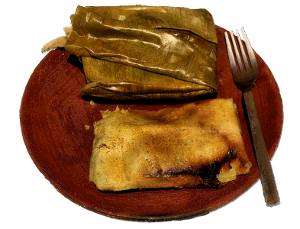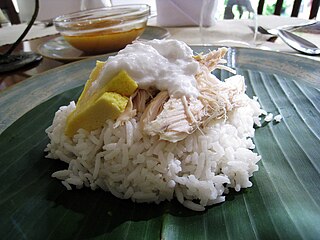| Alternative names | Dukana, Dukanoo, Tie A Leaf, Blue Drawers, Conkie |
|---|---|
| Type | Dumpling or Dessert |
| Place of origin | Caribbean |
| Created by | Descendants of Africa |
| Main ingredients | Sweet potatoes, sugar, flour, coconut, water, raisins, nutmeg, salt, vanilla extract |
| Variations | can be compared to Tie A Leaf which uses the cornmeal instead of the flour |
| Culture of Antigua and Barbuda |
|---|
Ducana is a sweet potato dumpling or pudding from Antigua, [1] Saint Kitts and Nevis, Saint Vincent and the Grenadines, Jamaica and many other Caribbean islands.
They are made from grated sweet potatoes, grated coconut, sugar, flour, coconut milk, and/or water, raisins, ginger, grated nutmeg, salt and essence or vanilla extract. The mixture is combined in a bowl until it thickly coats the back of a spoon. The cooking method is quite simple, but what is often debated is the wrapping. The mixture can be cooked wrapped in foil where others prefer to cook it wrapped in coccoloba leaves, [2] banana leaves, [3] or seaside grape leaves. Either way the wrapped contents must be boiled in salted water for about 25 minutes or until the mixture in the wrapping is firm.
Ducana is often served with salt cod [4] (bacala) and what the islanders call "chop-up" which is a mixture of spinach, eggplant and okra. Ducana is also eaten cold, or thinly sliced and fried lightly.

A tamale, in Spanish tamal, is a traditional Mesoamerican dish made of masa, a dough made from nixtamalized corn, which is steamed in a corn husk or banana leaves. The wrapping can either be discarded prior to eating or used as a plate. Tamales can be filled with meats, cheeses, fruits, vegetables, herbs, chilies, or any preparation according to taste, and both the filling and the cooking liquid may be seasoned.

Glutinous rice is a type of rice grown mainly in Southeast and East Asia, and the northeastern regions of South Asia, which has opaque grains, very low amylose content, and is especially sticky when cooked. It is widely consumed across Asia.

Roti is a round flatbread native to the Indian subcontinent. It is commonly consumed in many South Asian countries.

Malay cuisine is the traditional food of the ethnic Malays of Southeast Asia, residing in modern-day Malaysia, Indonesia, Singapore, Brunei, Southern Thailand and the Philippines as well as Cocos Islands, Christmas Island, Sri Lanka and South Africa.

Trinidad and Tobago has a unique history and its food is influenced by Indian-South Asian, West African, Creole, European, American, Chinese, Amerindian, and Latin American culinary styles. Trinidadian and Tobagonian food is dominated by a wide selection of dishes, most notably, doubles, pelau, callaloo and curried crab and dumplings. Trinidad and Tobago is also known for its prepared provisions, such as dasheen, sweet potato, eddoes, cassava, yam, soups and stews, also known as blue food across the country. Corresponding to the Blue Food Day event held annually in Trinidad and Tobago.

Kuih are bite-sized snack or dessert foods commonly found in Southeast Asia and China. It is a fairly broad term which may include items that would be called cakes, cookies, dumplings, pudding, biscuits, or pastries in English and are usually made from rice or glutinous rice. In China, where the term originates from, kueh or koé (粿) in the Min Nan languages refers to snacks which are typically made from rice but can occasionally be made from other grains such as wheat. The term kuih is widely used in Malaysia, Brunei, and Singapore, kueh is used in Singapore and Indonesia, kue is used in Indonesia only, all three refer to sweet or savoury desserts.

Taro is a root vegetable. It is the most widely cultivated species of several plants in the family Araceae that are used as vegetables for their corms, leaves, stems and petioles. Taro corms are a food staple in African, Oceanic, East Asian, Southeast Asian and South Asian cultures. Taro is believed to be one of the earliest cultivated plants.

Gujarati cuisine is the cuisine of the Indian state of Gujarat. The typical Gujarati thali consists of rotli, dal or curry, rice, and shaak. The thali will also include preparations made from pulses or whole beans such as moong, black eyed beans etc., a snack item (farsaan) like dhokla, pathra, samosa, fafda, etc. and a sweet (mishthaan) like mohanthal, jalebi, doodh pak etc.

A rice cake may be any kind of food item made from rice that has been shaped, condensed, or otherwise combined into a single object. A wide variety of rice cakes exist in many different cultures in which rice is eaten and are particularly prevalent in Korea and Japan. Common variations include cakes made with rice flour, those made from ground rice, and those made from whole grains of rice compressed together or combined with some other binding substance.

Bubur cha cha, also spelled as bubur cha-cha or dubo jiajie, is a Betawi and Malay dessert and breakfast dish in Indonesian cuisine, Malaysian cuisine, Singaporean cuisine and Phuket cuisine (Thailand) prepared using pearled sago, sweet potatoes, yams, bananas, coconut milk, pandan leaves, sugar and salt. Grated coconut, coconut cream and water can be used as additional ingredients. The ingredients are cooked in coconut milk, and the dish can be served hot or cold. Bubur cha cha is also sold as a street food in many parts of Southeast Asia.

Suman or budbud is a rice cake originating in the Philippines. It is made from glutinous rice cooked in coconut milk, often wrapped in banana leaves, coconut leaves, or buli or buri palm (Corypha) leaves for steaming. It is usually eaten sprinkled with sugar or laden with latik. A widespread variant of suman uses cassava instead of glutinous rice.

Puto is a Filipino steamed rice cake, traditionally made from slightly fermented rice dough (galapong). It is eaten as is or as an accompaniment to a number of savoury dishes. Puto is also an umbrella term for various kinds of indigenous steamed cakes, including those made without rice. It is a sub-type of kakanin.

Coconut rice is a dish prepared by cooking white rice in coconut milk or coconut flakes. As both the coconut and the rice-plant are commonly found in the tropics all around the world, coconut rice too is found in many cultures throughout the world, spanning across the equator from Southeast Asia, the Indian subcontinent, South America, Central America, West Africa, East Africa, the Caribbean and Oceania.

Javanese cuisine is the cuisine of Javanese people, a major ethnic group in Indonesia, more precisely the province of Central Java, Yogyakarta and East Java.

Belizean cuisine is an amalgamation of all ethnicities in the nation of Belize and their respectively wide variety of foods. Breakfast often consists of sides of bread, flour tortillas, or fry jacks that are often homemade and eaten with various cheeses. All are often accompanied with refried beans, cheeses, and various forms of eggs, etc. Inclusive is also cereal along with milk, coffee, or tea.

The traditions of West Africa and the United Kingdom have the biggest impact on the culture of Antigua and Barbuda. As a crucial component of its culture, Antigua and Barbuda also has its own creole language.

Fijian cuisine has long-consisted of primarily foraged and farm-grown food. Although rice, wheat, and tea all became staples during Fiji's colonial era, native Fijians still eat primarily tubers and coconuts. The cuisine of Fiji is known for its seafood and various green vegetables, including ''ota'', a young forest fern, and ''bele'', a plant that resembles spinach.

A great variety of cassava-based dishes are consumed in the regions where cassava is cultivated, and the ingredient is included many national or ethnic specialities.
Duckunoo or duckanoo, also referred to as tie-a-leaf, blue drawers (draws), dokonon, and dukunou is a dessert in Jamaica, Antigua and Barbuda, Barbados, French Guiana and some other Lesser Antilles. It is a variation on the dish ducana which originated in Africa. The Caribbean cuisine dish is made from batata, sweet potato, coconut, spices and brown sugar, all tied up in a banana leaf. It is then cooked in boiling water.

Botok or ꦧꦺꦴꦛꦺꦴꦏ꧀(Bothok) is a traditional Javanese dish made from grated coconut flesh which has been squeezed of its coconut milk, often mixed with other ingredients such as vegetables or fish, and wrapped in banana leaf and steamed. It is commonly found in Javanese people area of Java Island (Yogyakarta Special Region, Central, and East Java. It has a soft texture like the mozzarella cheese, and is usually colored white.